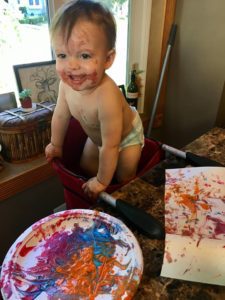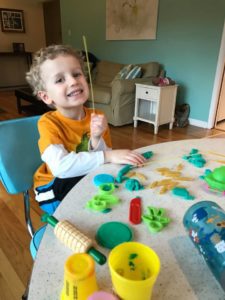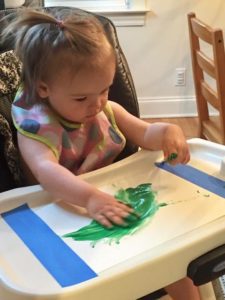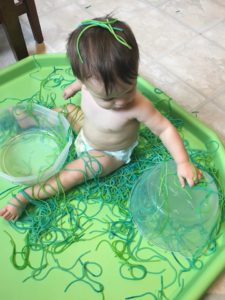Your DIY preschool just wouldn’t be complete without some fun sensory play. Sensory play is a fancy way of describing any activity where a child is free to discover and play with materials such as water, sand, clay, paint, dirt, etc. If I’m being honest, sensory play is not my favorite thing, especially as a mom. Sure, my kid might have a blast, but dealing with a living room littered with rice or a toddler covered in paint, ready to put her hands on anything and everything is not really my idea of a good time.
But, in addition to being a blast for your little one, sensory play is full of discovery and learning opportunities, which is why any preschool classroom you visit will have lots of sensory activities. Through digging, scooping, dumping, and squishing children are making connections, testing theories, and expanding their vocabulary which are foundational skills for reading, math and science. And chances are if it’s messy and fun enough it might just hold your little one’s attention for more than five minutes, which is another huge perk! Still not ready to break out the sand table in your living room? With a little planning and a few clever tricks sensory play can be a little less intimidating. Let’s break it down.
THE TOOLKIT
Many materials for sensory play are super inexpensive, and available at the dollar store, or right out of your kitchen sink! Beyond the actual sensory material you’ll use, a sensory table is nice to have on hand, but can be a little pricy. A large plastic bin works just as well and can go right on the floor or on a child’s table with a towel underneath to catch any spills. If you’re handy this table is inexpensive and great to use in or outdoors.
In addition to a container to hold your materials, you’ll want to have a few measuring cups and scoops on hand, and a bucket or two. For painting a bottle or two of basic washable paint works just fine, as well as a few brushes. Playdough is another quick sensory activity I like to have on hand. Store bought is just fine, but I also love this easy recipe. If I’m feeling fancy I add a few drops of lemon essential oil at the end for really fresh smelling dough. Add a few cookie cutters and you’re good to go!

HAVE AN EXIT STRATEGY
So you’ve got your supplies on hand, but before you play take a few minutes to come up with a plan for clean up. I learned this lesson in the classroom and use it when doing messy activities with my child at home: have an exit strategy! For me knowing what the plan for clean up is before we get messy gives me the confidence I need to dive into sensory play. Using sand or rice indoors? Have the broom and vacuum ready. Painting? Have baby wipes and a bucket of soapy water and rags ready. If your little one still uses a high chair, strap them in and they’ll be contained for painting and other really messy activities. When sensory play time is done include your child in clean up, letting them sweep or wipe down table. Or if they’re really messy go straight into the bath!

PLAN A DAY OR TWO
It’s great to include a little sensory play every day, but that doesn’t mean you need to go all out seven days a week. For my own sanity I pick one or two days a week for the really messy stuff, like finger painting or the rice tub. The other days of the week we keep it simple with playdough or other easy clean up activities. Limiting the big projects to a day or two helps me keep my sanity, and still gives my daughter lots of different sensory play opportunities. Of course when she asks to paint on days we hadn’t planned to I can’t resist my little artist, I just get my exit strategy ready!
TAKE IT OUTSIDE
When the weather is warm enough, take your sensory play outside! While it’s not an option all year long, take advantage of opportunities to get outside with your little one and get messy. A small water or sand table is a great investment, is fairly inexpensive and can provide lots of fun. There are lots of options on amazon like this one, or a cheap kiddie pool works just fine too. Bring those scoops and measuring cups outside and just add water!

Another great activity outside is gardening, and this DMB article has lots of great tips. A bucket, shovel and a patch of dirt can keep my daughter busy for quite a while, and we just visit the hose to wash off as best we can before we head in. Splashing in the pool, visiting the neighborhood park sandbox and splashing in puddles after the rain are other perfect summertime sensory activities. And while we all know Michigan winters are freezing, snow is a perfect (and free!) sensory material. Go outside and play in it, or bring it inside and put it in your sensory bin with some scoops and spoons and have a ball tillit melts!
IDEAS AND RESOURCES
Kids really don’t need much to have a blast with sensory play, and basic materials like water and paint work just fine. But if you’re looking for more ideas there are lots of great resources out there. One of my favorite instagram accounts and websites to follow is the Busy Toddler, full of great sensory and other learning activities that are quick to throw together. I also love this book, and it’s full of great ideas and recipes. Pinterest has a ton of great ideas, just search the material you want to use and browse through ideas to try!

GIVE IT TIME
You may have spent time planning the perfect sensory activity for your child, lovingly set it up, then experienced the joy of having them play with it for one minute and walking away. Or perhaps your child hates to be messy and wants nothing to do with it. While frustrating, these are not uncommon experiences. Keep it simple at first, and keep offering opportunities and chances are they will likely come around. If your little one hates getting messy, offer more tools to limit the contact they have with the material on their hands (brushes instead of finger painting, scoops and spoons for bins) and keep some wipes accessible for them to use as they wish. With a little time, planning and patience a new world of messy fun play and learning is yours for the taking!










